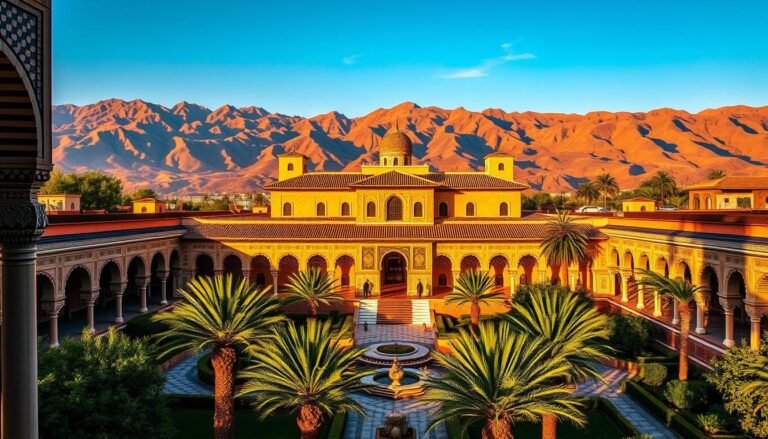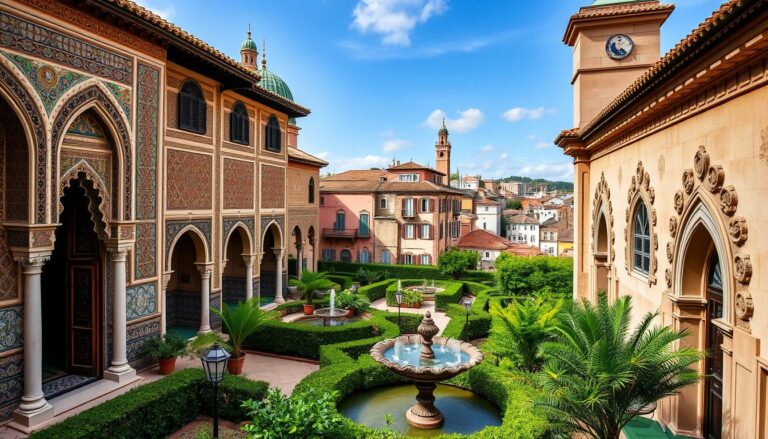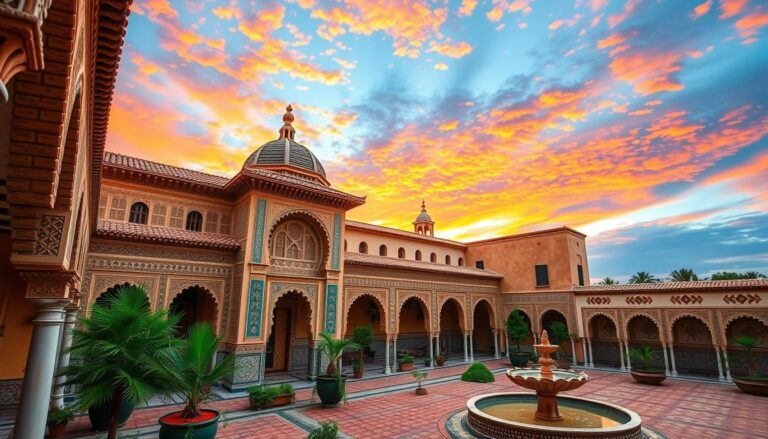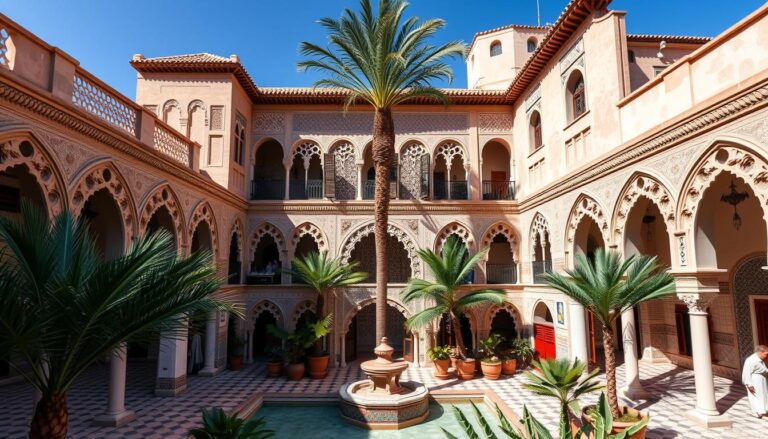In a world where interior design trends change often, Moroccan style stands out. It has won the hearts of many design lovers. But what makes Moroccan design unique, and how can you add it to your home?
Moroccan design mixes Berber, Islamic, and European traditions. It’s a blend of exotic beauty and modern flair. With bright colors, detailed carvings, and Moorish architecture, it creates a special and inviting space.
Key Takeaways
- Moroccan interior design seamlessly combines traditional North African design with contemporary aesthetics
- The style is characterized by vibrant colors, textured fabrics, and Moorish architectural elements
- Moroccan interiors feature a mix of light luxe neutrals, metallic accents, and earthy tones
- Dark, rich woods are commonly paired with metal for a striking juxtaposition
- Moroccan-inspired designs often incorporate artisan detailing and handcrafted elements
So, why do people love Moroccan interior design so much? Let’s explore its origins, key features, and how it’s interpreted today.
Unveiling the Origins of Moroccan Interior Design
Moroccan interior design comes from the rich Moorish architecture. This style thrived in Western Islamic culture from the 7th to the 15th centuries. The Moors, or Andalusians, brought their Muslim faith and unique architecture to North Africa and parts of the Western Mediterranean.
This blend of Berber culture and Islamic art created the distinctive Moroccan design we know today.
Moorish Architecture: The Foundation of Moroccan Decor
The Moorish style is key to Moroccan interiors’ charm. Features like the horseshoe arch, tiered gardens, and Zellij mosaic tilework come from this heritage. These elements make Moroccan spaces both beautiful and functional.
Iconic Examples: The Mosque of Cordoba and Beyond
The Mosque of Cordoba in Spain is a prime example of Moorish architecture. It’s famous for its double arches, stunning mosaics, and the hypostyle hall with 856 columns. Even after Muslim rule ended, this style influenced other architectural movements in the region.
“The Moorish architectural style has left an indelible mark on Moroccan interior design, seamlessly blending cultural influences and timeless elegance.”
Captivating Elements of Contemporary Moroccan Interior Design
Moroccan interior design is all about rich history and vibrant colors. It combines Moorish styles with a natural, earthy look. At its core are three key elements: the Moroccan arch, the Mashrabiya window, and the stunning Moroccan lighting.
Arches: The Iconic Moorish Architectural Feature
The Moroccan arch is a symbol of Moorish architecture. These beautiful arches are seen in alcoves, doorways, and windows. They bring a sense of grandeur and timeless beauty to any space.
From the ornate horseshoe arches to the elegant keyhole arches, they add a unique Moorish charm. This charm makes Moroccan-inspired spaces truly captivating.
Mashrabiya Windows: Crafting Ventilation and Beauty
The Mashrabiya is a traditional Islamic window design. It’s made of carved wood latticework. These windows cool spaces naturally and add beauty.
They have delicate, geometric patterns that create beautiful shadows and filter light. This makes interiors feel mysterious and enchanting.
Lamps and Lanterns: Illuminating Moroccan Artistry
Moroccan lighting is a key part of its design. There are two main styles: stained-glass lamps and hand-painted goatskin lamps. Both styles are made with care and showcase Moroccan artistry.
These lamps and lanterns light up Moroccan interiors. They also highlight the country’s rich artisanal heritage.
From the Moroccan arch to the Mashrabiya windows and the enchanting lighting, these elements bring Moroccan interiors to life. They transport us to a world full of color and beauty.
“Moroccan interior design embraces a vibrant color palette, including deep blues, vibrant reds, and earthy oranges to evoke the vibrant spirit of Moroccan culture and design.”
Contemporary Moroccan Interior Design: A Kaleidoscope of Colors, Textures, and Materials
Moroccan interior design is a mix of bright colors, rich textures, and interesting materials. It captures the essence of Morocco, from its sunny landscapes to detailed architecture. This design style brings Morocco’s beauty into modern homes.
Vibrant Hues and Earthy Tones: A Colorful Tapestry
Moroccan color palettes are a treat for the eyes. Modern homes often use soft colors like sand, taupe, and beige. But traditional Moroccan design loves bold, bright colors.
Colors like fuchsia, royal blue, and deep purple add luxury and grandeur. They make you feel like you’re walking through Marrakech’s streets.
Textiles, Metals, and Stones: A Tactile Feast
Moroccan textiles are key in creating the look. Silks, chenille, and kilim rugs add texture and depth. Wrought iron, copper, and gold are used for lighting and furniture.
Stone, like marble and zellige tiles, covers walls and floors. It adds to the rich, tactile Moroccan design elements.
The mix of bright colors, luxurious Moroccan materials, and patterns makes for a rich Moroccan decor experience. It feels like stepping into North Africa’s heart.
Embracing the Bohemian Spirit with Moroccan Furnishings and Accessories
Moroccan interior design is all about embracing a bohemian spirit. It loves unique, handcrafted pieces over the usual ones. You’ll find intricately carved tables and plush furniture that makes your space feel cozy and inviting.
These Moroccan furniture items mix the country’s rich culture with a modern, eclectic vibe. It’s a perfect blend of old and new.
Gardens: Oases of Tranquility and Symmetry
Moroccan gardens, or riads, are like peaceful oases. They’re designed to be symmetrical and inward-facing. Inside, you’ll find fountains, citrus trees, and roses that fill the air with sweet scents.
These Moroccan gardens offer a calm escape from the city’s noise. The landscaping and architecture, like arched doors and tilework, add to the balance and beauty.
Accessories: Layering Moroccan Charm
- Wooden bowls and ornate mirrors
- Hand-painted ceramics and stained-glass vases
- Vibrant textiles and intricate Moroccan accessories
Decorative items like these are key to adding Moroccan charm to your home. They bring warmth and personality to your space. With so many Moroccan accessories to choose from, you can make your home truly unique.
“Moroccan design incorporates influences from Berber tribes of North Africa, Mediterranean, Middle East, and beyond, creating a rich tapestry of cultural heritage.”
By embracing the bohemian spirit and using Moroccan furnishings and accessories, you can turn your home into a peaceful oasis. It will show off the timeless beauty of Moroccan design.
Conclusion: Bringing the Magic of Morocco into Your Home
Moroccan home design is a mix of exotic elegance and modern style. It draws from the rich Moorish architectural heritage. By adding elements like arched doorways and vibrant colors, you can make your home feel like Morocco.
Key design elements include Mashrabiya windows and intricate lamps. Handcrafted furnishings also play a big role. These elements can turn your home into a beautiful oasis.
Moroccan tiles and pottery bring vibrant colors and patterns to your home. They add depth and cultural richness. These authentic pieces can make any room special.
By using Moroccan design, you can create a space that feels like Marrakech or Fez. It’s all about finding the right balance between old and new. Mix bold accents and textures to make your space unique.
Remember, the magic of Morocco is in the details. With creativity and a love for Moroccan design, your home can become a stunning Moroccan-inspired oasis.
Source Links
- Modern Moroccan Budget Bedroom Reveal – Jenna Sue Design
- 5 Contemporary Moroccan Interior Design Ideas
- Moroccan Interior Design 101 | Amity Worrel & Co.
- Luxurious Moroccan Interior Design
- Contemporary Moroccan Interiors – Yaz Magazine
- 15 Exotic Moroccan Interior Design Ideas for Inspired Living
- What is Moroccan Interior Design? – HGTV
- 15 Exotic Moroccan Bathroom Ideas for Tranquility
- Moroccan wallpapers for Walls – Peel and Stick or Non-pasted
- Discover 34 Inspiring Interior Design Styles and learn how to implement them – axxla interior design
- Embracing Cultural Fusion: Moroccan Style and Bohemian Style
- Bohemian & Morrocan Interior Design – The Ultimate Guide
- 5 Must Knows for Mastering Moroccan Boho Design » Redecor
- Moroccan Tile Magic: Unraveling the Enchanting Beauty of Zellige
- Ceramics from Fez: Between Tradition and Modernity » Produits Ceramic

The Editorial Team is a passionate group of Morocco enthusiasts dedicated to sharing the beauty, culture, and wonders of this captivating country. With diverse backgrounds and a deep love for travel, we strive to bring you engaging and informative content that inspires your Moroccan adventures. From uncovering hidden gems and sharing local insights to exploring mouthwatering cuisine and showcasing the vibrant lifestyle, our team is committed to providing you with valuable resources and exciting stories that enhance your exploration of Morocco. Join us on this journey as we celebrate the rich heritage and unforgettable experiences that make Morocco truly special.







